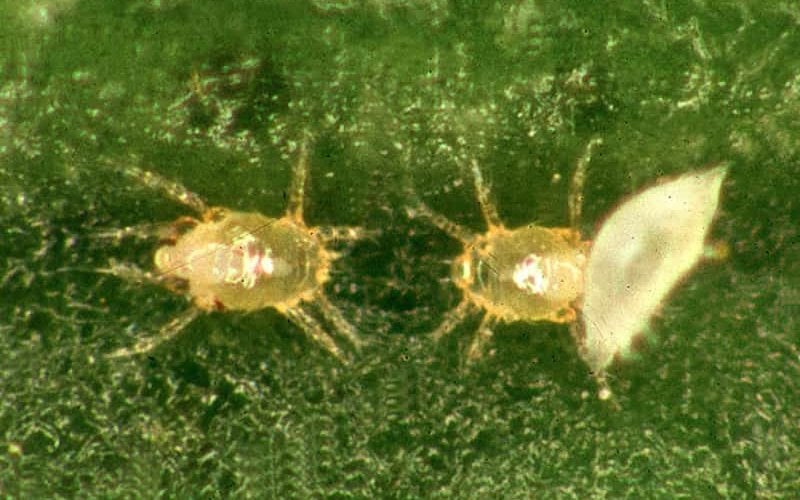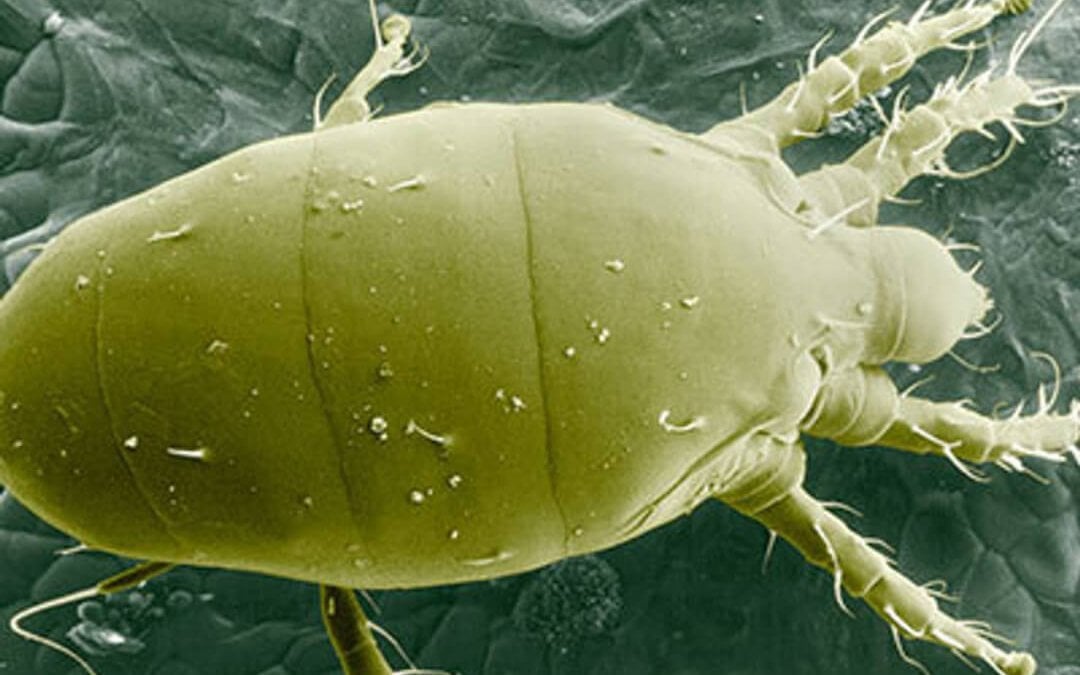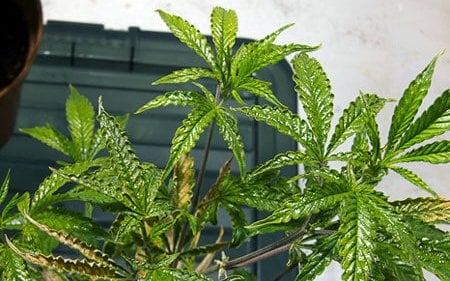Broad Mites On Cannabis: How To Deal With Them?
Are you noticing a change in the foliage of your crop but unsure of what’s causing the damage? Your marijuana plants may have become hosts to broad mites.
When it comes to the health of your cannabis plants, identifying these pests is vital. They’re microscopic annoyances that suck the life out of your crops without leaving early detection signs.
It’s not easy to see these pin-head-sized nuances before an infestation occurs. Being informed puts you a step ahead of a situation that could be detrimental to your plants. The symptoms are similar to nutrient deficiencies and other crop viruses.
Read up on their appearance and how to spot and eliminate them before broad mite damage hurts your plants.
What are broad mites?
Polyphagotarsonemus latus (broad mites) are microscopic parasites found on plants. Often undetectable by the naked eye, they appear as tiny little drops with legs on the surface of leaves. They’re part of the Arachnida family and aren’t classified as insects.
If you’re cultivating marijuana crops in a tropical or temperate climate, you’ll likely experience a broad mite cannabis infestation at some stage. They especially favor greenhouse environments.
These tiny predators reproduce quickly to expand their population on one single plant. They crawl through the canopy while feeding off the sap of leaves. Parasites like these inject a toxic growth regulator into the crop, causing a nutrient deficiency.
They move between crops on top of whiteflies and aphids, or when the male migrates the female to other plants.
Broad mites on cannabis are destructive to the health of your plants. Unlike larvae of fungus gnats on cannabis roots, these eight-legged pests suck out liquids needed for growth.

What does a broad mite look like?
It’s hard to see these creatures by simply looking at your plants. Even with a 60x magnifying glass, you can only see the oval-shaped eggs on the underside of the leaves.
With a microscope on hand, you may be able to identify these parasites on your cannabis plants.
What do broad mites look like? Adult mites have inflated oval-shaped, yellow to amber, and sometimes greenish bodies. Attached to the thorax are medium-sized heads with defined mouth appendages. They have piercing mandibles that suck the sap out of leaves and plant cells.

Though similar in appearance, certain qualities separate the males from the females. Take note of these characteristics to differentiate between the two broad mite genders:
Females:
- 0.008 inches in length
- Have four sets of legs with the rear two resembling hair strands
- Have a light stripe at the back end of the body
- Female broad mites on weed plants move around slowly
Males:
- 0.004 inches in length
- Have four sets of legs; the rear ones are large and strong
- No stripe on the body
- Move faster than females
The good news is that broad mite eggs are much easier to identify. Inspect the underside of the leaves or the exterior of flowers and look for 0.003-inch, clear, oblong shapes. The colorless nits have white spots on the surface.
Newly hatched eggs called larvae only have three sets of legs. The tiny ridges on their bodies give them a whitish color.
The life cycle of a broad mite
The life cycle of broad mites on cannabis is rapid and short-lived. Within a 5–13 day period, males impregnate females, after which they lay eggs and die. Males have a lifespan of 5–9 days.
Without fertilization, females produce male offspring. After mating, they lay 30–76 eggs over 8–13 days, with a gender ratio of four females to one male.
Applying a broad mites treatment at this stage to eliminate lurking adults won’t eradicate the eggs. They firmly attach themselves to the plant material, making it hard to dislodge them.
These cannabis parasites have four life cycle stages:
- Eggs: Hatch within 2–3 days.
- Larvae: Emerge from the hatched eggs and instantly feed on plant material.
- Nymphs: Morph into quiescent larval after 2–3 days. The faster-developed males carry dormant females to new growth or other plants to start the reproductive process over again.
- Adults: When females progress from the quiescent stage, males immediately mate with them.
Symptoms of a broad mite infestation on cannabis plants
Coming across predatory bugs on weed is every grower’s nightmare. It’s even more frustrating when you can’t quickly identify them on the plants due to their size. Thankfully, you can rely on the signs your crops present during growth.
One unfortunate thing about broad mites' symptoms on cannabis is that they aren’t visible until 20–30 days after infestation. These pests don’t simultaneously attack all parts of the plant. The mites feed on young parts like leaves, buds, and growing tips.
The leaves have brown spots and connected stripe patterns if mild invasions are present. In more severe cases, the network is denser, with the green plant matter almost non-existent (apart from the veins).
Broad mite feeding sites create patterns of yellow dots on the leaves' surface, causing them to turn darker.
Your marijuana plants usually present the following symptoms when there’s an infestation:
- New growth on the crops droops or twists
- The leaves seem wet and blistered
- Edges of the foliage turn up (similar symptom to cannabis heat stress)
- Distorted growth results in warped plants
- Young leaves are brown around the edges
- Stunted crop growth
- Yellowing of leaves and stems
- Broad mites damage cannabis buds during the flowering stage, causing them to turn brown and wilt

Broad mites damage to cannabis plants
Broad mites damage the meristematic cells crops need to grow. Draining the plant of these tissues prohibits maturation in the growing tips and apical shoots.
Broad mite leaf damage runs much deeper than discrepancies on the surface. Cannabis pests and diseases cause significant damage to the health of growing plants. It’s easy to confuse the afflictions with those caused by the Tobacco Mosaic Virus (TMV).
In both instances, the subsequent after-effects of infection cause discoloration of leaves. Despite the systematic facial damage these cannabis broad mites cause, what does it do to the livelihood of the plants?
When these parasites feed, the rest of the crops receive fewer nutrients. Fewer minerals mean weaker plants, which leads to:
- Stunted growth
- A decrease in leaf numbers
- Smaller leaves
- Reduced crop height
How to get rid of broad mites on weed plants
If you think powdery mildew is your biggest threat, think again. Broad mites on weed are one of the toughest pests to eliminate.
Learn how to eradicate broad mites naturally to keep your plant and buds chemical-free. Remember that whatever you spray onto your crop, you may inhale or ingest it at a later stage.
After positively identifying an infestation, act swiftly to get rid of them. The first and most vital thing to do is remove infected parts of the plants from your growing space and discard them.
Here are some ways to eradicate these mites using natural miticides:
- Neem oil for cannabis: This solution is an extraction from neem seeds mixed into a foliar spray to mist over your plants. It’s effective as eradication or a preventative measure. Don’t spray near bud sites during flowering. It has a distinctive undesirable scent and aroma.
- Insecticidal sulfur soaps: An eco-friendly broad mite cannabis treatment for more minor infestations.
- Biocontrol: Introduce other predatory insects like Neoseiulus californicus to feed on the mites.
- Heat: These pests don’t like anything above 90℉. Slightly increase temperature and humidity levels to minimize reproductive levels significantly.
- Essentria IC3: Blends of horticultural oils aimed at combating pests in a natural and non-harmful way. Use a mister to apply it to the plant until the mites disappear.
- Spinosad: What kills broad mites? An organic pesticide like spinosad does. Apply once daily to the infected parts of the plant to instantly eradicate these arachnids.
- Trifecta crop control: Various blends of essential oils to prevent or rid crops of pests.
Continue applying the treatment for up to five weeks after eradicating the pests. Sterilize the growing space as well as any equipment used.

How to prevent broad mites on cannabis plants
Outdoors, the mites use the wind or other creatures as traveling vessels between plants. Controlled setups create the ideal environment for them to live and breed.
Instead of wondering how to get rid of broad mites, try and prevent them from appearing. Along with an integrated pest management program (IPMP), adopt the following procedures:
- Clones are the number one migrators of broad mites. Quarantine and treat new plants for a few days before taking them into your growing space. It’s best to plant from seed to eliminate cross-contamination.
- Do regular check-ups on your crops. Broad mite identification in the early stages of infestation gives you a fighting chance to save them.
- Provide the ideal environment. Check that the pH for cannabis is normal. Ensure that ventilation, circulation, humidity, temperature, and air intake filters are on point. These pests thrive in growing temperatures of 60–70℉ and high humidity levels of 60–80%.
- Use diatomaceous earth to sprinkle onto the soil, or mix the powder with water to spray onto the foliage. It’s an organic treatment that tears and dehydrates mites.
- Treat your plants often with natural preventative miticides.
- Healthy plants have robust immune systems, which allows them to tolerate infestations longer until a broad mites cannabis treatment is applied. Use a quality fertilizer for cannabis crops to help build their resistance to pests and diseases.
Microscopic trickery
Detecting the presence of these parasites isn’t easy, but possible. Regularly take note of the condition of your plants to see early broad mite damage.
Check for the telltale signs of an infestation before confusing it with other deficiencies or viruses. Keep an IPMP handy to stay on top of your treatment schedule, and remember, prevention is better than cure. The minute you notice any broad mites symptoms, take action immediately.
Connect with Homegrown Cannabis Co. for quality seeds, supplies, and advice on managing broad mites.

FAQs about broad mites on cannabis
With so much to learn about broad mites on cannabis, here’s a quick reference to some frequently asked questions.
Can I use heat for treatment?
Yes, you can use heat to treat broad mites on weed. Some growers submerge their entire plant (including the pot) into 110℉ water for 30 minutes to get rid of them. This temperature is safe for the plant. Alternatively, increase the air temperature to 115℉ for 15–20 minutes.
Do broad mites appear in greenhouses?
These mites live and breed in greenhouse setups with temperatures between 60–70℉ and relative humidity of 60–80%. They spread among the crops through air currents, contact between plants, or workers handling the plants.
Control the environment in your indoor growing space to avoid broad mite damage to your weed.
Do broad mites damage buds?
Broad mite damage on cannabis plants significantly affects their growth, including the flowering of buds. While feeding, they drain crops of vital nutrients that buds need to thrive. Damaged flowers turn brown and eventually die.
About the Author: Kyle Kushman
Kyle Kushman is a legend in the cannabis community. He is the modern-day polymath of pot: cultivator, breeder, activist, writer, and educator. After winning no less than 13 Cannabis Cups, there’s nothing this guy doesn’t know about indoor growing - he’s been there, done it, and is still doing it to this day!
